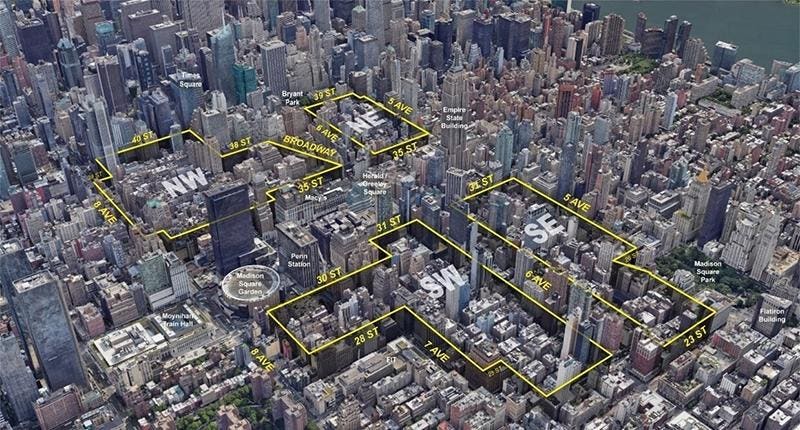In a landmark decision that could fundamentally alter the character of Manhattan, New York City officials have greenlit an ambitious rezoning initiative that promises to transform 42 blocks of Midtown South from an industrial relic into a vibrant, round-the-clock residential and commercial hub. The Midtown South Mixed-Use (MSMX) Plan represents one of the most significant urban planning undertakings in recent memory, addressing the city’s acute housing shortage while reimagining how Manhattan’s core can evolve for the 21st century.
Understanding the Scope of Change
The MSMX Plan encompasses a substantial swath of Manhattan real estate, spanning four distinct districts that have long been constrained by outdated manufacturing zoning regulations. This 42-block transformation zone stretches across areas that, despite their prime location in the heart of Manhattan, have remained underutilized due to zoning restrictions that no longer reflect the economic realities of modern New York.
The rezoning initiative represents a philosophical shift in urban planning, moving away from the rigid segregation of industrial and residential uses that characterized mid-20th century city planning. Instead, it embraces a mixed-use model that recognizes the complex, interconnected nature of modern urban life, where work, residence, and recreation increasingly blur together.
The Four Target Districts
The plan focuses on four key areas within Midtown South, each presenting unique opportunities and challenges. These districts have been selected based on their potential for transformation, existing infrastructure capacity, and strategic importance to Manhattan’s overall development goals. The comprehensive approach ensures that the changes will create a cohesive, interconnected community rather than isolated pockets of development.
Addressing New York’s Housing Crisis Head-On
The MSMX Plan arrives at a critical moment for New York City’s housing market. With rental prices reaching historic highs and homeownership remaining out of reach for many middle-class families, the city faces an unprecedented affordability crisis. The rezoning initiative directly confronts this challenge by unlocking significant residential development potential in one of Manhattan’s most desirable areas.
Housing advocates have long argued that New York’s zoning laws, many of which date back decades, have artificially constrained housing supply in areas with excellent transportation access and job opportunities. The Midtown South rezoning represents a bold attempt to break this cycle, creating opportunities for thousands of new residential units in an area that currently houses relatively few people despite its prime location.
Mixed-Income Housing Opportunities
The plan’s emphasis on mixed-use development creates opportunities for diverse housing options, from luxury condominiums to more affordable rental units. This diversity is crucial for maintaining the socioeconomic mix that has historically made New York neighborhoods vibrant and dynamic. The rezoning framework includes provisions for affordable housing components, ensuring that the transformation benefits residents across the income spectrum.
Economic Implications and Market Response
The approval of the MSMX Plan has significant implications for Manhattan’s commercial real estate market. Property values in the affected areas are likely to see substantial increases as the development potential of these parcels expands dramatically. This presents both opportunities and challenges for existing businesses and property owners in the area.
Real estate developers and investors are already eyeing the newly rezoned areas with considerable interest. The plan effectively transforms underutilized manufacturing and warehouse spaces into some of the most valuable development sites in Manhattan. This shift could trigger a wave of new construction projects that will reshape the neighborhood’s skyline over the coming decade.
Impact on Local Businesses
The transformation raises important questions about the fate of existing manufacturing and industrial businesses in the area. While many of these operations may no longer be economically viable in prime Manhattan real estate, the city faces the challenge of ensuring that the transition doesn’t result in significant job losses or the displacement of businesses that serve important community functions.
Urban Planning Philosophy: From Single-Use to Mixed-Use
The MSMX Plan reflects a broader evolution in urban planning thinking, moving away from the strict separation of uses that characterized much of 20th-century city planning. The concept of a “24/7 mixed-use district” acknowledges that vibrant urban neighborhoods function best when they combine residential, commercial, and office uses in close proximity.
This integrated approach offers numerous benefits, including reduced commuting times, enhanced street-level activity throughout the day and night, and more efficient use of urban infrastructure. By creating a neighborhood where people can live, work, and socialize within a compact area, the plan supports more sustainable urban living patterns.
Lessons from Global Urban Development
The Midtown South rezoning draws inspiration from successful mixed-use developments in cities around the world. From London’s King’s Cross redevelopment to Toronto’s waterfront transformation, urban planners have increasingly recognized the value of creating integrated districts that serve multiple functions. These international examples provide valuable insights into both the opportunities and potential pitfalls of large-scale urban transformation.
Challenges and Potential Drawbacks
Despite its ambitious goals, the MSMX Plan faces several significant challenges. Infrastructure capacity represents perhaps the most pressing concern, as the area’s existing transportation, utilities, and services may require substantial upgrades to accommodate a dramatic increase in residential population.
The subway system, while extensive, may experience increased congestion during peak hours as more residents move into the area. Similarly, schools, healthcare facilities, and other community services will need to expand to serve the growing population.
Gentrification Concerns
The rezoning also raises concerns about gentrification and displacement in surrounding areas. As property values rise and the neighborhood transforms, longtime residents and businesses in adjacent areas may face pressure from increasing rents and changing neighborhood character. City officials will need to carefully monitor these effects and implement measures to protect vulnerable communities.
Implementation Timeline and Next Steps
The approval of the MSMX Plan marks just the beginning of what will likely be a decade-long transformation process. Developers must now navigate the complex process of securing financing, obtaining building permits, and coordinating construction projects in one of the world’s most challenging building environments.
City agencies will need to coordinate closely to ensure that infrastructure improvements keep pace with new development. This includes everything from subway capacity enhancements to the installation of new utility lines and the creation of public spaces that serve the growing community.
Looking Toward the Future
The Midtown South rezoning represents more than just a local planning initiative; it serves as a potential model for how cities can adapt their regulatory frameworks to meet 21st-century challenges. If successful, the MSMX Plan could provide a blueprint for similar transformations in other underutilized areas of New York and cities worldwide.
The project’s emphasis on mixed-use development, housing diversity, and 24-hour neighborhood vitality aligns with broader trends in urban planning that prioritize sustainability, walkability, and community integration. As climate change and economic pressures continue to shape urban development patterns, the lessons learned from this ambitious undertaking will prove invaluable for future planning efforts.
Key Takeaways
- Massive Scale: The MSMX Plan covers 42 blocks across four districts in Midtown South, representing one of NYC’s largest recent rezoning initiatives
- Housing Crisis Response: The plan directly addresses New York’s acute housing shortage by enabling residential development in a prime Manhattan location
- Mixed-Use Vision: The initiative promotes integrated living, working, and recreational spaces to create a vibrant 24/7 community
- Economic Impact: Property values and development activity are expected to increase significantly in the affected areas
- Infrastructure Challenges: Success will depend on coordinated improvements to transportation, utilities, and community services
- Gentrification Risks: City officials must carefully monitor and mitigate potential displacement effects in surrounding neighborhoods
- Long-term Timeline: Full transformation is expected to unfold over approximately a decade
This article is based on reporting from the original source

Born and raised amidst the hustle and bustle of the Big Apple, I’ve witnessed the city’s many exciting phases. When I’m not exploring the city or penning down my thoughts, you can find me sipping on a cup of coffee at my favorite local café, playing chess or planning my next trip. For the last twelve years, I’ve been living in South Williamsburg with my partner Berenike.

